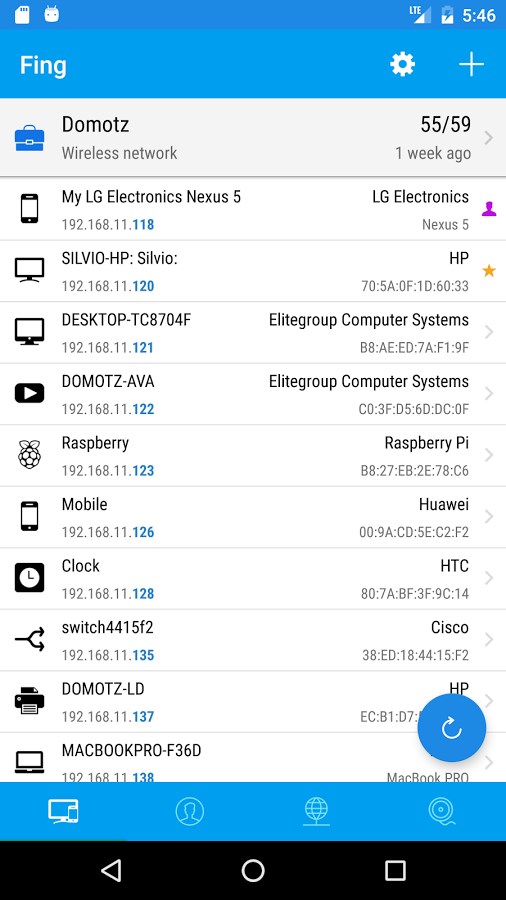

- FING FOR MAC OSX HOW TO
- FING FOR MAC OSX FOR ANDROID
- FING FOR MAC OSX SOFTWARE
- FING FOR MAC OSX FREE

FING FOR MAC OSX SOFTWARE
We answer your questions within 24-48 hours (Weekend off).Ĭhannel: If you want the latest software updates and discussion about any software in your pocket, then here is our Telegram channel.I’m not paranoid about network security, but I wanted to know if some device joins my network. You may also use our social and accounts by following the Whatsapp, Facebook, and Twitter for your questions. Our Contact: Kindly use our contact page regards any help.
FING FOR MAC OSX HOW TO
Want to add an alternate method: If anyone wants to add the more methods to the guide How to Remotely Wake a Mac from Sleep with Wake On LAN from iPhone, then kindly contact us. Misinformation: If you want to correct any misinformation about the guide “How to Remotely Wake a Mac from Sleep with Wake On LAN from iPhone, ” kindly contact us. How to Remotely Wake a Mac from Sleep with Wake On LAN from iPhone Tutorial: final noteįor our visitors: If you have any queries regards the How to Remotely Wake a Mac from Sleep with Wake On LAN from iPhone, then please ask us through the comment section below or directly contact us.Įducation: This guide or tutorial is just for educational purposes. How to Remotely Wake a Mac from Sleep with Wake On LAN from iPhone Guide is free? Since this sometimes requires router configuration, it is beyond the scope of this article.

FING FOR MAC OSX FREE
This is done by configuring the router’s IP address and an open port that forwards to the Mac with WOL support – this too is optional, and other free WOL apps may support the feature also, but you should check it yourself.
FING FOR MAC OSX FOR ANDROID
The Fing app is also accessible for Android users, downloadable from the Google Play Store, which would make the installation almost identical to the steps above, or you can use something called Mafro WakeOnLan, and it’s free too, using a slightly different interface.Īnd with the optional setting available through the NetStatus app, you can use Wake On LAN over the wider internet, meaning you don’t have to be on the same Wi-Fi network for it to work beyond the initial setup. The initial setup on the OS X side is the same, but of course, you’ll need to use an Android app to wake up the Mac and complete the second set of steps. Yes, Android phones can also wake up Macs (or Windows PCs) using the same Wake On LAN protocol, so if you don’t have an iPhone, don’t worry. Can you use WOL from an Android smartphone to wake up a Mac or PC? You may also want to review the setup process again and ensure you don’t miss any steps. Read Also: How to run the Android 12 beta on Android If you have problems setting this up or making it work, you can try a few different things: Your Mac can be awake and waiting for you when you walk in the door, or to wake up up a remote computer for an SSH connection, or to wake up up your work computer when you enter the office door or, assuming Wi-Fi goes far enough, when you are in the parking lot. This is great for situations such as arriving on home. Now that it is configured and confirmed to work, you can wake up remotely up the sleeping Mac with just the Fing app on the iPhone, as long as you’re on the same Wi-Fi network. Instead, the screen usually stays black, but the hardware is awake and active, receiving network connections, pings, and anything else you want to do with the machine. This is because using the WOL protocol to wake a Mac from sleep does not necessarily wake the device’s screen with the default locked login screen that greets a Mac user when they are on a sleeping Macs spacebar. This is easiest to test if you have another machine or device that you can ping on to detect the WOL Mac has been woken up via network access, but it is not necessary. Now open the Fing app on the iPhone, find the “Wake On LAN Home(Or whatever you call it) machine you configured in the second set of steps, and choose “Wake On Lan” again – this time it will wake the sleeping Mac up.On the Mac, open the Apple menu and choose “Sleep” as usual, give the machine a minute or so to make sure it sleeps, or watch the pulsing indicator light if the Mac has one.


 0 kommentar(er)
0 kommentar(er)
